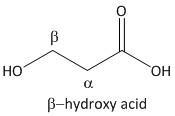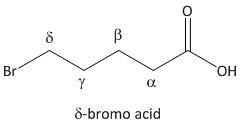
Which will form lactone on treatment with NaOH?
A. α-bromo acid
B. β-bromo acid
C. β-hydroxy acid
D. δ-bromo acid
Answer
475.8k+ views
Hint:
Complete step by step answer:
This is an example of lactonization reaction. This is a very useful reaction in organic chemistry for converting a straight chain compound into a cyclic ring compound.
In lactonization of an acid by removal of a halogen two key points are important. One is the ability of the leaving group to be a good leaving group. The other is the formation of ring size which depends on the strain of the ring formed. The six membered ring formations are the most favoured ones.
Let us take the lactonization of

The formation of tetrahydro-
Let us check the given starting materials for the formation of lactones.
α-bromo acid.

From the above mechanism the lactone formation is not possible for α-bromo acid.
β-bromo acid.

From the above mechanism the lactone formation is not possible for β-bromo acid as it leads to a highly strained four membered lactone which is not favorable.
β-hydroxy acid.

From the above mechanism the lactone formation is not possible for β-hydroxy acid due to unavailability of a good leaving group.
δ-bromo acid.

From the above mechanism the lactone formation is possible for δ-bromo acid. In fact the
So, the correct answer is “Option D”.
Note: The lactonization with
Complete step by step answer:
This is an example of lactonization reaction. This is a very useful reaction in organic chemistry for converting a straight chain compound into a cyclic ring compound.
In lactonization of an acid by removal of a halogen two key points are important. One is the ability of the leaving group to be a good leaving group. The other is the formation of ring size which depends on the strain of the ring formed. The six membered ring formations are the most favoured ones.
Let us take the lactonization of

The formation of tetrahydro-
Let us check the given starting materials for the formation of lactones.
α-bromo acid.

From the above mechanism the lactone formation is not possible for α-bromo acid.
β-bromo acid.

From the above mechanism the lactone formation is not possible for β-bromo acid as it leads to a highly strained four membered lactone which is not favorable.
β-hydroxy acid.

From the above mechanism the lactone formation is not possible for β-hydroxy acid due to unavailability of a good leaving group.
δ-bromo acid.

From the above mechanism the lactone formation is possible for δ-bromo acid. In fact the
So, the correct answer is “Option D”.
Note: The lactonization with
Recently Updated Pages
Master Class 11 Economics: Engaging Questions & Answers for Success

Master Class 11 Business Studies: Engaging Questions & Answers for Success

Master Class 11 Accountancy: Engaging Questions & Answers for Success

Master Class 11 English: Engaging Questions & Answers for Success

Master Class 11 Computer Science: Engaging Questions & Answers for Success

Master Class 11 Maths: Engaging Questions & Answers for Success

Trending doubts
State and prove Bernoullis theorem class 11 physics CBSE

What are Quantum numbers Explain the quantum number class 11 chemistry CBSE

Write the differences between monocot plants and dicot class 11 biology CBSE

Why is steel more elastic than rubber class 11 physics CBSE

Explain why a There is no atmosphere on the moon b class 11 physics CBSE

1 ton equals to A 100 kg B 1000 kg C 10 kg D 10000 class 11 physics CBSE




